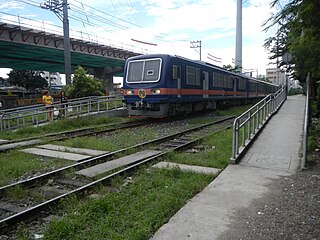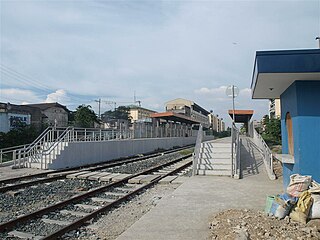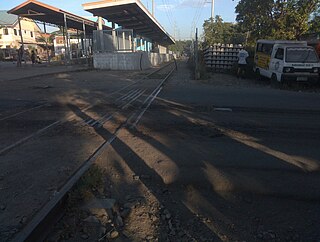
Rail transportation in the Philippines presently is used mostly to transport passengers within Metro Manila and the nearby province of Laguna, as well as a commuter service in the Bicol Region. Freight transport is nonexistent, although there are plans for a revival from Port Area, Manila to Laguna, and a cargo train planned between Subic and Clark. Currently, the country has a railway footprint of only 212 kilometers (132 mi) through Line 1, Line 2, Line 3 and the Philippine National Railways' (PNR) Metro Commuter Line, although the government has stated to expand the network by 244 kilometers (152 mi) in Luzon, as well as building the 102 km (63 mi) first phase of the 1,550 kilometers (960 mi) Mindanao Railway expansion.
The public transportation system in Metro Manila, Philippines is inadequate to accommodate the mobility and other basic needs of a densely populated metropolis, the result of many factors and problems that the government has failed to deliver. Metro Manila exists in a state of heavy traffic congestion, with people and goods trapped by the very transportation system that is supposed to move them quickly and efficiently. Because of the insufficient public transportation network, car ownership has risen dramatically, contributing further to the congestion that occurs at all times of day on the road. Filipinos view cars as tools to get them to where they need to go; they also believe that their car is an important symbol of the success they have achieved in life. In recent years, however, the Philippine government has been pushing to improve the system through various infrastructure projects, hoping to solve the interlinked problems of transportation, land use and environment.

Buendia was a station on the South Main Line ("Southrail") of the Philippine National Railways. Like all PNR stations, this station is at grade. The station was located at the corner of Gil Puyat Avenue and the South Luzon Expressway in Makati.

5th Avenue station is a railway station of the Philippine National Railways as part of Governor Pascual - FTI Line. Facilities such as ramps and platforms were planned to be constructed near the railway crossing with C-3 Road in Caloocan, Metro Manila. The plans to rehabilitate this part of PNR's network were implemented but no concrete platforms were erected.

EDSA station is a station on the South Main Line ("Southrail") of the Philippine National Railways. Like all PNR stations, this station is at grade. The station is located at the intersection of the South Luzon Expressway and Epifanio de los Santos Avenue in Makati, below the Magallanes Interchange.

Pasay Road is a station on the South Main Line ("Southrail") of the Philippine National Railways. Like all PNR stations, this station is at grade. The station is located on Estacion Street in Barangay Pio del Pilar in Makati, making it only one of two stations to have its own access road. It is named after Pasay Road, the old name of the Makati section of Arnaiz Avenue.

FTI station is a station of the South Main Line ("Southrail") of the Philippine National Railways. Like all PNR stations, this station is at grade. It is located on the East Service Road of the South Luzon Expressway in Taguig, on the foot of the Metro Manila Skyway. It is named after its major landmark, the grounds of the formerly state-owned Food Terminal, Inc. which is now renamed as Arca South.

The transportation system in Metro Manila is currently inadequate to accommodate the mobility and other basic needs of an densely populated metropolis, the result of many factors and problems that the government has failed to provide or address. Metro Manila exists in a state of near-permanent gridlock, with people and goods trapped by the very transportation system that is supposed to move them quickly and efficiently.

Solis station is a railway station of the Philippine National Railways as part of the Governor Pascual - FTI Line. Like all PNR stations, the station is at grade. It is located and situated along the railroad crossing on Solis St. in Tondo, Manila.

Caloocan railway station is a railway station of the Philippine National Railways (PNR) as part of the Governor Pascual - FTI line. It is rebuilt from its original location, now located and situated adjacent to Apolinario Mabini St., and along the railroad crossing on Samson Road in Caloocan, Metro Manila.

San Pedro station is a railway station on the South Main Line (Southrail) of the Philippine National Railways. Like most of the PNR stations operating under Metro South Commuter, the station is at grade. It is located in San Pedro, Laguna, within the city proper.

The Philippine National Railways Metro Commuter Line is a commuter rail line operated by the Philippine National Railways, stretching from Tondo, Manila to the southern and northern edge of Metro Manila. Presently, there are 31 railway stations. The current line is colored orange on most maps.
San Pedro-Carmona Resettlement station, often shortened to Carmona, was the terminus of the San Pedro-Carmona Line. The line was built to serve the San Pedro-Carmona Resettlement Center.

Manila Rapid Transit Line 9, formerly known as the Mega Manila Subway, is an underground rapid transit line currently under construction in Metro Manila, Philippines. The 36-kilometer (22 mi) line, which will run north–south between the cities of Quezon City, Pasig, Makati, Taguig and Pasay, will serve fifteen stations between the Quirino Highway and FTI stations. It will also serve as the country's second direct airport rail link, with a branch line to Ninoy Aquino International Airport. The line is designed to connect with the other urban rail transit services in the region, including Line 1, Line 3, and Line 7 at the North Avenue Common station, which is also currently under construction; the existing Line 2 and Metro Commuter Line; and the planned Line 5 and Line 8.

Dela Rosa is a station on the South Main Line ("Southrail") of the Philippine National Railways. Like all PNR stations, this station is at grade. The station is located at the corner of Dela Rosa Street and the South Luzon Expressway in Makati.
The Makati Intra-city Subway Line 5 is an 11-kilometer (6.8 mi) planned underground rapid transit line to be located in Makati, Metro Manila, that will link establishments across the city's business district. It will be built under a public-private partnership program between the Makati City Government and a private consortium, led by Philippine Infradev Holdings. Proponents of the subway began construction in December 2018, and Makati Mayor Abigail Binay projects completion by the year 2025. The subway will cost $3.7 billion and is expected to accommodate 700,000 passengers daily. It will also have eleven stations, with connections to the existing Line 3, the Pasig River Ferry Service, and the approved Line 9.

Governor Pascual railway station is a railway station of the Philippine National Railways (PNR). It is located and situated adjacent to Governor Pascual Avenue, Barangay Acacia in Malabon, Metro Manila.

The North–South Commuter Railway or NSCR, also known as the Clark–Calamba Railway, is a 147 kilometer elevated railway under construction. It will run from New Clark City in Capas, Tarlac to Calamba, Laguna, with a total of 36 stations. It will also feature the first direct airport link in the country, serving Clark International Airport.



















